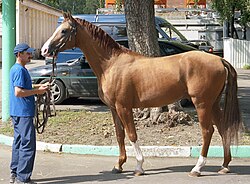Don horse
| Don horse | |
|---|---|

|
|
| Important data | |
| Origin: | Russia, on the Don |
| Main breeding area: | Russia |
| Distribution: | especially Russia |
| Stick measure : | 158-168 cm |
| Colors : | predominantly gold foxes |
| Main application area: | versatile riding horse |
The Don horse is the traditional horse of the Don Cossacks , whose ancestors had lived in the Russian steppe for thousands of years. They also played a part in the expulsion of Napoleon's Great Army , which made them world famous.
Background information on horse evaluation and breeding can be found under: Exterior , interior and horse breeding .
Exterior
The medium-sized, straight or concave head sits on a well-shaped, sometimes slightly straight neck. The chest is broad, the back short and the wide, long croup slopes down at an angle. The previously widespread backward bending position of the front legs and a saber-legged position of the hind legs are rarely found. The average height of the stallions is 162 cm. The vast majority of Don horses are gold foxes with a remarkable metallic sheen. White markings - especially blessen - are common.
interior
The Don horse has the tough constitution of the steppe horse to this day. It is persistent and undemanding, insensitive to the weather and has a long service life. The temperament is balanced. At the same time, the Don horse has a vivacity that it inherited from its Turkmen ancestors.
Even today, the Don horse is used as a shepherd horse in the steppe and in the mountains. It is also used for trail rides and for recreational sports . The Don horse has good jumping abilities. It performs particularly well in long distance races . Because of its complete fearlessness, it is very suitable as a police horse . The Don horse is still mainly used as a riding horse. Today it is also used in agriculture as a light draft horse.
Breeding history
As early as the 18th century, the Don horses, tamed by nomads, were systematically refined by crossing Mongolian and oriental races as well as Arabian stallions. From the 19th century horse breeds from the west were crossed because the chunky Dons had many building defects. From the 1920s onwards, only pure-bred breeding was used. The aim of breeding was to adapt the horses to the needs of the military.
The Don horse formed the basis for the relatively new breed of horse the Budjonny and was also used in the breeding of numerous other Russian horse breeds. These include the Kustanai (horse) , the Tersker , Kazakh (horse) .
See also
literature
- Jasper Nissen: Encyclopedia of Horse Breeds . Franckh-Kosmos Verlags GmbH & Co, Stuttgart 2003, ISBN 3-440-09723-4 .
- Bonnie Lou Hendricks: International Encyclopedia of Horse Breeds . University of Oklahoma Press, 1995, ISBN 9780806138848 .
